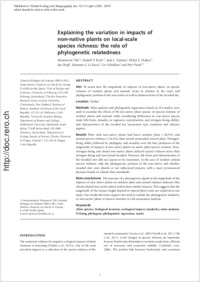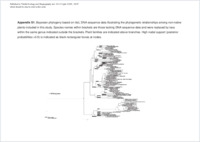Explaining the variation in impacts of non-native plants on local-scale species richness: the role of phylogenetic relatedness
- Vilà, Montserrat Estación Biológica de Doñana (EBD-CSIC), Sevilla, Spain
- Rohr, Rudolf P. Estación Biológica de Doñana (EBD-CSIC), Sevilla, Spain - Unit of Ecology and Evolution, University of Fribourg, Switzerland
- Espinar, José L. Estación Biológica de Doñana (EBD-CSIC), Sevilla, Spain
- Hulme, Philip E. The Bio-Protection Research Centre, Lincoln University, Christchurch, New Zealand
- Pergl, Jan Institute of Botany, Academy of Sciences of the Czech Republic, Průhonice, Czech Republic
- Roux, Johannes J. Le Centre for Invasion Biology, Department of Botany and Zoology, Stellenbosch University, Matieland, South Africa
- Schaffner, Urs CABI Switzerland, Delémont, Switzerland
- Pyšek, Petr Institute of Botany, Academy of Sciences of the Czech Republic, Průhonice, Czech Republic - Department of Ecology, Faculty of Science, Charles University in Prague, Czech Republic
-
01.11.2014
Published in:
- Global Ecology and Biogeography. - 2015, vol. 24, no. 2, p. 139-146
Alien species
Biological invasion
Ecological impact
Insularity
Meta analysis
N fixing
Phylogeny
Phylogenetic regression
Weeds
English
Aim: To assess how the magnitude of impacts of non-native plants on species richness of resident plants and animals varies in relation to the traits and phylogenetic position of the non-native as well as characteristics of the invaded site.Location: Global.Methods: Meta-analysis and phylogenetic regressions based on 216 studies were used to examine the effects of 96 non-native plant species on species richness of resident plants and animals while considering differences in non-native species traits (life-form, clonality or vegetative reproduction, and nitrogen-fixing ability) and characteristics of the invaded site (ecosystem type, insularity and climatic region).Results: Plots with non-native plants had lower resident plant (–20.5%) and animal species richness (–26.4%) than paired uninvaded control plots. Nitrogen-fixing ability, followed by phylogeny and clonality were the best predictors of the magnitude of impacts of non-native plants on native plant species richness. Non-nitrogen-fixing and clonal non-native plants reduced species richness more than nitrogen-fixing and non-clonal invaders. However, life-form and characteristics of the invaded sites did not appear to be important. In the case of resident animal species richness, only the phylogenetic position of the non-native and whether invaded sites were islands or not influenced impacts, with a more pronounced decrease found on islands than mainlands.Main conclusions: The presence of a phylogenetic signal on the magnitude of the impacts of non-native plants on resident plant and animal richness indicates that closely related non-native plants tend to have similar impacts. This suggests that the magnitude of the impact might depend on shared plant traits not explored in our study. Our results therefore support the need to include the phylogenetic similarity of non-native plants to known invaders in risk assessment analysis.
- Faculty
- Faculté des sciences et de médecine
- Department
- Département de Biologie
- Language
-
- English
- Classification
- Biological sciences
- License
-
License undefined
- Identifiers
-
- RERO DOC 233039
- DOI 10.1111/geb.12249
- Persistent URL
- https://folia.unifr.ch/unifr/documents/303921
Other files
Statistics
Document views: 105
File downloads:
- pdf: 211
- Supplementary material: 150

